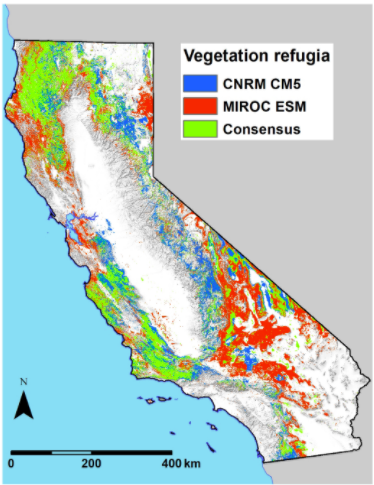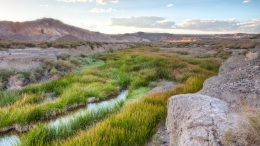For more than a century, the famous formation of long, symmetric columns of basalt have drawn tourists to marvel at the geology of Devils Postpile National Monument near Mammoth Lakes, California.
But recently scientists have found another interesting natural feature in the park. A valley with high walls and a north-south alignment blocks sunlight and traps cold air, creating cool temperatures that, they believe, may become a kind of refuge for plants and animals facing a warming world.
All across the world rising temperatures are changing ecosystems and threatening some of the species evolved to live in those places, forcing them to try to adapt or move. That’s why scientists are focusing attention on a field of study — climate-change refugia — that could help improve conservation and minimize biodiversity loss in the face of climate change.
The journal Frontiers in Ecology and the Environment dedicated its newest issue to the topic, with studies about how to identify, protect and manage these important areas. Authors in the issue say these climate-change refugia — areas largely buffered from current climate change effects because of unique local conditions, like the valley at Devils Postpile — could serve as ecological safe havens.
“As the effects of climate change accelerate, climate‐change refugia provide a slow lane to enable persistence of focal resources in the short term, and transitional havens in the long term,” wrote scientists in the issue’s first study, which was led by Toni Lyn Morelli, a research ecologist at the USGS Northeast Climate Adaptation Science Center. “Planned wisely, they can serve as stepping‐stones for multiple species as climates continue to change.”
Necessary Steps
The first challenge is identifying and mapping potential refugia — some of which could be small “microrefugia.” Then, according to the study, land and water managers need to shift natural resource priorities to protect and monitor these areas, which may face additional threats besides climate change.
Some groundwater-fed springs, for example, could be important refugia for conserving both freshwater and terrestrial species. But these freshwater sources also can be polluted, drained by groundwater pumping, trampled by livestock, or altered by invasive species or other human activities.

Comprehensive efforts to address these threats have historically been rare, the researchers say, because springs aren’t often included in federal regulations that protect other water bodies, like lakes, streams and wetlands.
That’s why it’s critical to identify refugia and raise awareness about their important ecological value.
“Subsets of springs are likely to become ‘oases of the future,’ providing the kinds of hydrologic refugia needed to maintain groundwater‐dependent biodiversity in the coming decades,” wrote scientists in another study in the journal, led by USGS biologist Jennifer M. Cartwright.
Refugia in Practice
There’s still a lot to be learned about climate-change refugia, but state and federal agencies have started putting some of what they know into practice.
Research in California, for example, found that nearly 15% of the state’s lands could be a refuge for the region’s plants as the climate changes — particularly areas of the northwest Klamath Mountains, the northern Sierra Nevada and California’s Central Coast Ranges. But some iconic species — like coast redwoods and coast live oak — are likely to face climate stress in much of their range in future decades.

The state’s Department of Fish and Wildlife is also looking at what these vegetation changes could mean for California’s 522 vertebrate species and how their ranges may shift over time.
Research to understand which plants species will fare best in certain locations in the future is also helping guide some of the reforestation and restoration work in California’s El Dorado National Forest following the 2014 King Fire, so species are not replanted in areas where they’re not likely to thrive with future warming. The practice could be adopted in other areas following large-scale disturbances.
“A more thorough evaluation of climate exposure and predicted locations of refugia could better inform species‐specific planting decisions with respect to site selection, planting densities and seed sources,” wrote researchers in a study led by James H. Thorne, a research scientist at U.C. Davis, published in the journal.
In fact, scientists have honed in on “disturbance refugia” — areas that experience less severe or less frequent disturbance by forces like fire, drought and insects than their surroundings and could provide another kind of refuge.
For example, islands of forest canopy that haven’t burned in wildfires provide reservoirs of genetic plant diversity that may be critical for land restoration and regeneration after a fire, found researchers in a study led by Oregon State ecology professor Meg A. Krawchuk.
While scientists agree that identifying and protecting these refugia are important tools in working to safeguard biodiversity, they also acknowledge that it’s not a static process. Many climate-change refugia are likely to be temporary “stepping-stone refugia” themselves as climate changes intensify beyond 2100.
Some, however, could endure longer.
“If the existing species assemblages persist over even longer times, then these locations might be considered climate refugia in the long‐term sense of the word,” wrote Thorne. “It is our task to identify such potential areas and consider what interventions, if any, would best promote such a future.”
![]()



2 thoughts on “Climate Refugia: Protecting Biodiversity in the Face of Climate Change”
Comments are closed.